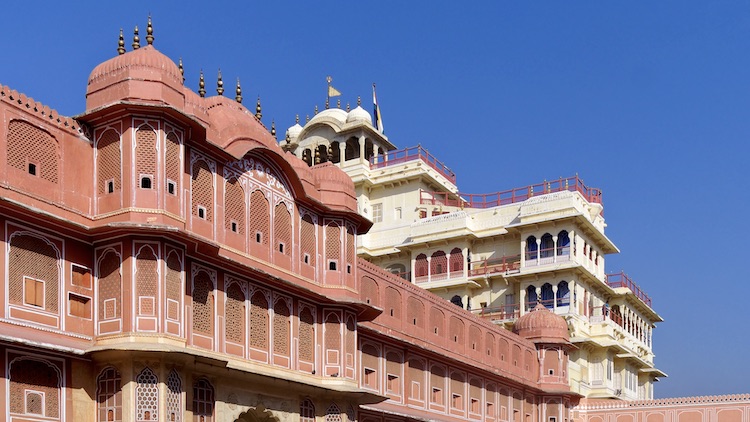Jaipur, widely recognized as the Pink City of India, is a renowned tourist destination in the Indian state of Rajasthan. Established in 1727 by Maharaja Sawai Jai Singh II, Jaipur captivates visitors with its historical charm. Among Jaipur’s most famous palaces, stands the City Palace. The City Palace of Jaipur is a majestic heritage site that exemplifies a fusion of Mughal, European, and Rajput architectural styles, symbolizing the grandeur of Indian culture.
Nestled within an imposing structure, the City Palace Jaipur encompasses a vast complex comprising various halls, palaces, gardens, museums, gateways, and sacred shrines. Originally constructed as a residence for the royal families, it stands as a testament to their regal legacy.
As one of the most iconic tourist spots in the Golden Triangle of India, countless visitors flock to the palace to see how the royal lives of the kings and queens of Jaipur lived. And, in this blog I will give you everything you need to know about the City Palace in Jaipur, so you too, can walk the grounds of the palace like the kings and queens did.
Quick Facts about the City Palace in Jaipur:
Below are some quick facts to know about before visiting the famous City Palace in Jaipur.
- City Palace Distance from the Airport: 12.0 KM from Jaipur International Airport.
- Location of the City Palace in Jaipur: Jaleb Chowk, Near Jantar Mantar, Tripolia Bazar, Jaipur, Rajasthan.
- Operating Hours: 9.30 AM to 5.00 PM (Day visit), and 7.00 PM to 10.00 PM (Night visit)
- How much time do you need to see the City Palace? Plan to spend at least 3 hours while visiting the palace and its different sections.
- Palace Entry Fee: Charges are different for different places inside the Palace. However, Indians should pay INR 100 for exterior spaces and INR 130 for the museum. Foreigners should pay INR 500 for exterior spaces and INR 900 for the museum. Additional INR 150 is charged for carrying video graphical cameras.
- Visit Duration: 3-4 hours (Depends on the individual).
- Availability of Guides: Guides are available in different languages and the fee varies based on the number of people.
- Architect of the City Palace in Jaipur: Vidhyadhar Bhattacharya
- Style of the Palace: Fusion of Chalukya Architecture, Rajput Architecture, Mughal Architecture and Shilpa Shastra.
- Best time to visit the Palace: September to February.
How much are tickets for the City Palace in Jaipur?
The entry fees of the City Palace Jaipur ranges from INR 130 to INR 500. The table below shows the entry fees for the city palace in Jaipur:
| Guest | Museum | Museum at Night |
|---|---|---|
| Adult | 200 | 500 |
| Child (5-12 years) | 100 | 250 |
| Adult (Senior Citizen) | 100 | 380 |
There are additional categories of tickets and costs associated with entering the City Palace, they include:
- For Indians – INR 130
- For children – INR 70
- Foreign tourists – INR 500
- Photography Fee – INR 50
- Videography Fee – INR 150
- Sr. Citizen fees -INR 110
- Audio Guides – INR 200
How to Enter Jaipur’s City Palace?
There are two different gates at the City Palace that you can enter from – Udai Pol and Virendra Pol. Each of different facilities that can be seen below:
- Udai Pol: Ticket Counter, Golf Cart, Drinking Water, Cloakroom, Washrooms, Paid Parking, Bardari Restaurant and First Aid.
- Virendra Pol: Ticket Counter, Drinking Water, Reception for Audio, Golf Cart, Washrooms, Cloakroom and First Aid.
History of the City Palace in Jaipur:
Built between 1729 and 1732, the City Palace in Jaipur stands as a magnificent testament to heritage and rich culture in Rajasthan. Maharaja Sawai Jai Singh II initiated the construction, focusing primarily on the palace’s exterior architecture. The decision to move from Amber to Jaipur was motivated by a growing water scarcity issue, which led to insufficient water supply for the populace.
Seeking expertise, Jai Singh II enlisted the services of Vidhyadhar Bhattacharya, a Bengali architect renowned for his adherence to the principles of Vastushastra. This meticulous planning and design have solidified the City Palace’s status as the foremost attraction in the state, captivating visitors to this day.
Architecture of the Palace:
Within the premises of the City Palace, Jaipur, a diverse array of pavilions, gardens, and temples awaits. These architectural wonders come in various shapes and sizes. One encounters grand gateways, such as the Tripoli (Three Gates), the Udai Pol, and the Virendra Pol, serving as entrances to the complex.
While the latter two are accessible to the general public, the former is exclusively reserved for the royal families’ passage. Notable attractions within the palace grounds include the Chandra Mahal, the Mukut Mahal, the Shri Govind Dev Ji Temple, the Maharani’s Palace, the Mubarak Mahal, and the City Palace Museum.
Finally, the palace is covered in the famous red sandstone that the city has become famous for, and got the nickname – Pink City. Additionally, the architecture of the palace showcases a nice blend of European, Islamic, and Rajput styles.
Inside the City Palace, Jaipur:
There are different sections of the palace all with their own unique and exciting features. I recommend seeing each of them if you have enough time! So make sure to plan for at least 3 hours inside the complex.
Let’s now take a look at the different sections of the City Palace in the Pink City of India:
1. Chandra Mahal:
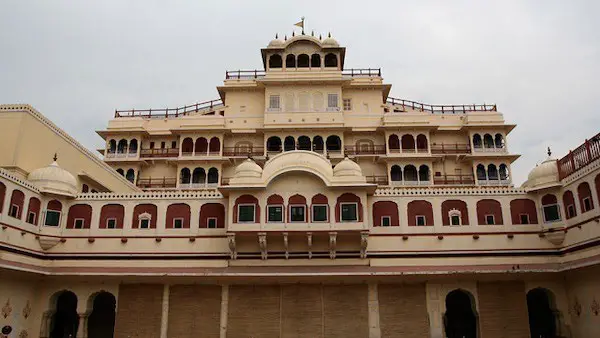
The Chandra Mahal, a magnificent seven-storied structure, boasts multiple floors, each with its distinct name and purpose. These floors include Mukut Mandir, Chabi Niwas, Shri Niwas, Ranga Mandir, Pitam Niwas, and Sukh Niwas. As you approach the entrance gate, you’ll be greeted by a captivating peacock sculpture, complemented by balconies and a roof pavilion. From this vantage point, you can enjoy breathtaking panoramic views of the city. Inside the palace, every segment dazzles with intricate mirror work, adorned with floral decorations and stunning paintings.
Originally intended as a residence for the rulers’ descendants, the Chandra Mahal now houses a museum on its ground floor, exhibiting manuscripts, carpets, and various artifacts (you can read more about the museum galleries below!) The Sukh Niwas comprises a dining hall and a lavishly decorated drawing room adorned with exquisite paintings. The Shobha Niwas, aptly named the Hall of Beauty, features ornate tiles and walls adorned with gold and mica mirrors. On the fifth floor, known as Chavi Niwas, the Maharajas used to find respite. Lastly, the topmost floor is reserved for the flag, indicating whether the Maharaja is present or away.
2. Mubarak Mahal:
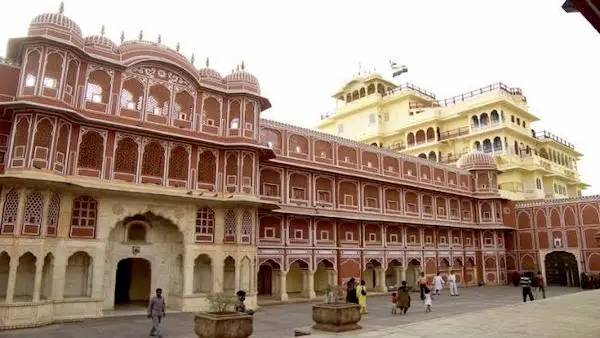
Constructed in the 19th century by Madho Singh II, the reception center known as the Mahal showcases a captivating blend of European, Islamic, and Rajput architectural styles. Originally designed as a museum, it currently houses a remarkable collection of textiles and garments.
Visitors can marvel at the exquisite display of embroidered clothes, Kashmiri Pashminas, Silk Sarees, and Sanganeri Shawls. Among the highlights is a unique set of clothing worn by the late Maho Singh I, featuring a remarkably wide cloth measuring 1.2 meters and weighing approximately 250 kilograms.
3. Pritam Niwas Chowk:
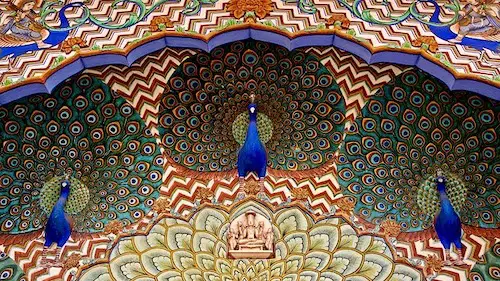
Within the City Palace, there is an inner courtyard featuring four distinct gates leading to a courtyard that portrays the four seasons of the year. Each of these gates showcases intricate peacock patterns, with the northwest gate representing autumn. This gate, dedicated to Lord Vishnu, is adorned with elaborate decorations.
The southwest gate, dedicated to Lord Shiva, is embellished with flowers and petals, symbolizing summer. The northeast gate, painted in green, represents spring and is dedicated to Lord Ganesha.
Finally, the southwest gate displays flower patterns representing winter and is dedicated to Devi, the Goddess.
4. Diwan-I-Aam:

Known as Sabha Niwas or the public hall, this magnificent space features vibrant red and gold ceilings adorned with warm hues. Functioning as an art gallery, it showcases a stunning collection of miniature Persian, Mughal, and Rajasthani paintings. The hall is adorned with embroidered rugs, ancient texts, carpets, and shawls, providing a glimpse into the rich artistic heritage of the region.
Among its notable treasures is a resplendent Golden throne, called Takth-e-Rawal, which serves as the centerpiece. Additionally, the hall houses exquisite depictions of palanquin bearers and majestic marble rock elephants, adding to its grandeur.
5. Diwan-I-Khas:
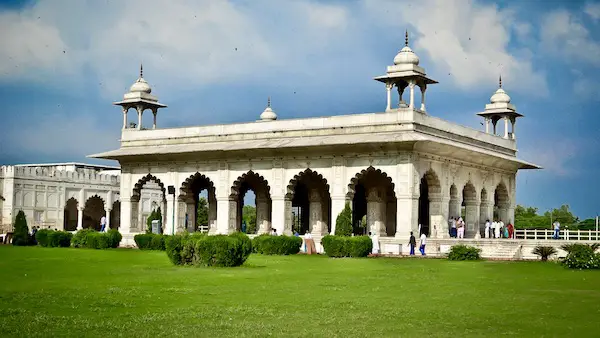
Nestled within the walls of this marble chamber lies a private hall reserved exclusively for the Maharajas. Its centerpiece is a remarkable pair of silver vessels standing at an impressive height of 1.6 meters, with a capacity to hold up to 4000 liters of liquid.
These extraordinary vessels, constructed from 14,000 silver coins without any soldering, collectively weigh approximately 340 kilograms. Their magnificence is further amplified by their inclusion in the Guinness Book of World Records as the largest silver vessels ever created.
The life of these vessels can be traced back to Madho Singh II’s visit to England in 1900 when he preferred not to consume the local water and instead carried the sacred Ganga Jal (water from the River Ganges) in these vessels. Alongside these remarkable silver creations, the hall also boasts dazzling crystal chandeliers, adding a touch of elegance to the regal ambiance.
6. Baggi Khana:
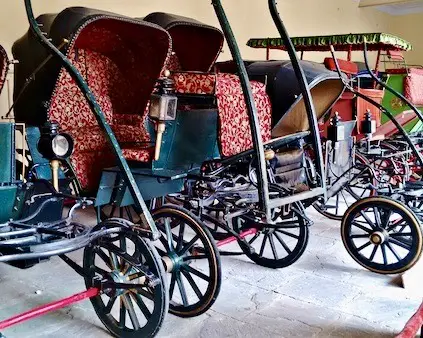
This renowned museum houses a remarkable assortment of palanquins, carriages, and European cabs, commonly known as Baggis. Among the notable exhibits is an ancient Victorian Bhaggi, bestowed upon the museum by the Prince of Wales in 1876. Additionally, there is a Mahadol, a simple bamboo-made carrier used for transporting Hindu deities and priests, particularly during festive occasions.
These artifacts provide a captivating glimpse into the rich cultural heritage and historical transportation methods in the region.
7. Maharani Palace:
Originally built as the royal abode for the queens of the royal family, the Maharani Palace has been transformed into a captivating museum showcasing weaponry from various historical eras. The palace’s ceiling is particularly renowned for its intricate frescoes crafted with gold, adding a touch of regalness to the surroundings. Visitors can explore the museum’s collection and gain insight into the diverse weaponry used throughout different periods of history in the region.
8. GovindDev Ji Temple:
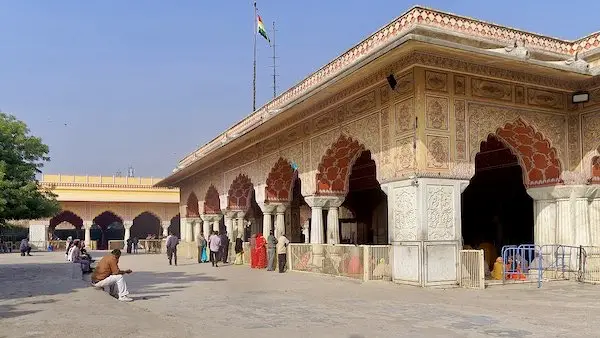
This is one of the most famous temples in Jaipur. Dedicated to Lord Krishna, it stands as a sacred shrine that dates back to the 18th century. Within its walls, one can marvel at a blend of Indian art paintings and European chandeliers, creating a unique fusion of cultural influences.
The grandeur of the temple is further enhanced by its ceilings adorned with golden accents, adding a touch of splendor to the divine surroundings.
Museum Galleries at the City Palace in Jaipur:
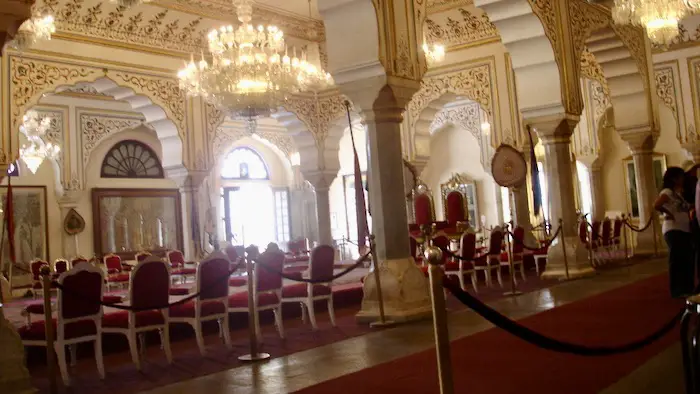
There are four different museum galleries that you can see at the City Palace in Jaipur. These museums comprise one of the most famous museums in Jaipur, and allow visitors to see the rich history of the maharajas of the area.
While exploring the different sections of the City Palace and the museum inside, make sure you also spend a little time checking out the artifacts and displays in the following Galleries:
1. Sabha Niwas (Hall of Audience):
Sabha Niwas known as the ‘Hall of Audience’ is a spacious room designed in a durbar style. It features two central thrones and a surrounding arrangement of chairs. The walls of the hall are adorned with large paintings showcasing the Maharajas of Jaipur, a significant pichwai serving as a shrine backdrop, and striking portrayals of the vibrant Holi festival (one of the most famous festivals in Jaipur).
Additionally, a pair of paintings depicting spring and summer, possibly originating from the Deccan region, grace the walls. As you explore the hall, you’ll also discover military medals and polo trophies that celebrate the achievements of the rulers. The room is lavishly decorated with intricate murals and elegant chandeliers, adding to its grandeur. Unfortunately, recently, the arches where the Holi paintings and the Spring and Summer portraits hang have been closed.
As you make your way through the corridor leading to the Sarvato Bhadra courtyard, you’ll encounter photographs from the reign of Man Singh II, capturing moments such as the court in attendance and the visit of Lord and Lady Mountbatten.
2. Textile Gallery:
Situated on the ground floor of the Mubarak Mahal, this gallery showcases a diverse array of textiles and fabrics. Among the highlights are notable pieces such as Maharaja Sawai Madho Singh I’s atmasukha, Maharaja Sawai Pratap Singh’s wedding jama, and a collection of robes (angarakhas) that belonged to Maharaja Sawai Ram Singh II.
A must-see is the exquisite pashmina carpet, crafted in Lahore or Kashmir around 1650, displaying exceptional artistry. Additionally, this gallery proudly exhibits the Polo outfit and cups once owned by Maharaja Sawai Man Singh II, as well as the billiards outfit worn by the same Maharaja.
3. Sileh Khana (Arms and Armour Gallery):
The Sileh khana displays arms used by the Kachhwaha Rajputs of Jaipur. Highlights of this museum section include early 19th-century swords with intricate decorations on the handles and blades. Notably, there are swords with chiseled animals along the blade, featuring raised figures, buildings, animals, and birds highlighted in gold.
The collection also features a tulwar owned by Maharaja Ram Singh Ji II, distinguished by its special purpose and stamped blade. Another notable piece is a tulwar belonging to Maharaja Sawai Madho Singh II, with a checkered grip and silver inlaid flowers on the hilt. The gallery includes a beautifully painted shield depicting the clan goddess, Shila Mata, and hunting scenes, attributed to Maharaja Sawai Pratap Singh.
Additionally, there is a unique metal child’s turban mimicking fabric and a rare 16th-century watered steel helmet adorned with later damascened decoration added during Maharaja Sawai Ram Singh II’s reign.
4. Painting and photography gallery:
The Painting and Photography Gallery at The Maharaja Sawai Man Singh II Museum showcases eighteenth- and nineteenth-century paintings and photographs from Jaipur. These artworks reflect the influence of political and cultural changes, modern technologies, and new materials on traditional artistic practices in the region.
Moreover, the gallery features Rajput paintings, including Jaipur’s unique style and hybrid styles influenced by Mughal and Persian traditions. The museum houses around 3,000 paintings, including Mughal and Deccani originals, Jaipur copies, religious and secular themes, portraits, nature studies, and more. Notable is Sahibram’s large-scale painting of the Raas-lila, depicting a court re-enactment where women played all roles, including Krishna.
The photography collection comprises 6,050 photographic prints, 1,941 glass plate negatives, and equipment dating from the 1860s to the 1950s. Noteworthy photographers include Lala Deen Dayal, Jonston & Hoffman, and Bourne & Shepherd. The glass plate negatives, primarily by Maharaja Sawai Ram Singh II, document portraits, landscapes, and art objects. Unique among them are the wet plate negatives capturing the lives of zenana women. Finally, the collection also includes photography equipment used by Maharaja Sawai Ram Singh II in the 1860s.
Tips for Travelers visiting the City Palace in Jaipur:
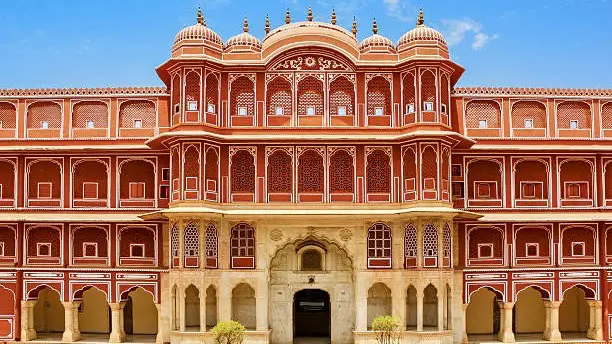
Below are a few things to keep in mind while visiting Jaipur’s City Palace:
- The City Palace Jaipur is a huge complex, requiring considerable walking, so it’s advisable to carry a water bottle with you (drinking water is available).
- Dress comfortably and wear flat footwear or good shoes for a more comfortable experience.
- The City Palace Jaipur is accessible to people with disabilities.
- Enquiry services for guides and other information are available at the entrance.
- Tickets can be purchased based on your preferences: individual, composite, or package tickets for different parts of the palace.
When is the best time to visit Jaipur City Palace?
Undoubtedly, the best time to explore Jaipur City Palace is early in the morning upon its opening. By doing so, you can surpass the crowds and enhance your chances of capturing the perfect photographs without crowds of people in the background.
Another great time to visit the City Palace in Jaipur is during the late afternoon. By this time, the number of visitors has dwindled, and the radiant golden light adds a captivating array of colors to the architecture.
In terms of the best months to visit, March to April is highly recommended for a visit to Jaipur due to the warm and pleasant weather. Additionally, October to February is another great time to visit as the climate tends to be cooler and dry. Between October and February, the city also comes alive as a lot of the festivals in Jaipur take place during this time!
Interesting Facts about the Palace:
Looking for some interesting facts most people don’t know about the palace? Then check out the list below!
- The City Palace was originally constructed by Sawai Jai Singh, the founder of the city. He also built nearby attractions like Hawa Mahal and Jantar Mantar.
- Architect Sir Samuel Swinton Jacob collaborated with Sawai Jai Singh in designing the City Palace.
- The third courtyard of the palace features four additional gates, each representing a different season.
- Presently, the City Palace Jaipur is divided into two parts: one accessible to the public and the other reserved for the royal families, who are the descendants of the rulers.
- The Silehkhanna within the palace serves as a museum displaying handguns and various weapons, including a diverse collection of arrows, axes, knives, and swords.
Other Places to Visit after the City Palace:
The City Palace is in the heart of Jaipur, with lots of other places to visit! After you are done exploring the palace make sure to see these other heritage sites:
- Jantar Mantar (100 m)
- Shopping Bazaars in Jaipur: Tripolia Bazaar (400 m), Johari Bazaar (1 km), Bapu Bazaar (2 km)
- Hawa Mahal (1 km)
- Albert Hall Museum (3 km)
- Birla Mandir (4 km)
- Jal Mahal (6 km)
- Amer Fort (8 km)
- Anokhi Museum (9 km)
- Jaigarh Fort (10 km)
- Nahargarh Fort (14 km)
The Majestic City Palace of Jaipur:
The City Palace of Jaipur is one of the most fascinating and beautiful places to visit in the city. When Pooja and I visited the palace we were mesmerized by the beauty and size of the complex. Whereas, when we visited the Hawa Mahal in Jaipur, it seemed small to us and not much to see. But, when we visited the City Palace, we were able to spend hours there – more than 3, but we wanted to see everything and take a lot of photos!
If you had to choose between one or the other (or a lot of other heritage sites in Jaipur), I would recommend going to the City Palace above the rest. The palace has a little of everything, so you get a nice mixture of culture, architecture, and history all in one place!
The City Palace of Jaipur is a massive area with lots to see, so you may want to consider getting a guide if you want to see everything there, and learn as much about the palace as possible. You can find guides waiting at the palace, but these can be a hit or miss depending on who is available and how much they try to charge you.
FAQs: City Palace Jaipur:
Below are some of the most frequently asked questions about the City Palace Jaipur.
2-3 hours is required to visit the City Palace in Jaipur.
When we visited we spent over 3 hours as we wanted ample time to see everything and take photos.
Yes, Jaipur City Palace is worth visiting. It makes up one of the largest tourist attractions in Jaipur and is known for its beautiful architecture, history, museums, and art.
Yes you can visit City Palace at night. There are two times to visit the palace, with operating hours from 9.30 a.m. to 5.00 p.m. and Night visit from 7:00 p.m. to 10:00 p.m.
The Royal Family of Jaipur currently lives in the City Palace Jaipur. Historically, it was the home of the famous Maharaja Sawai Man Singh II.
